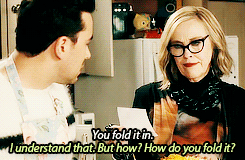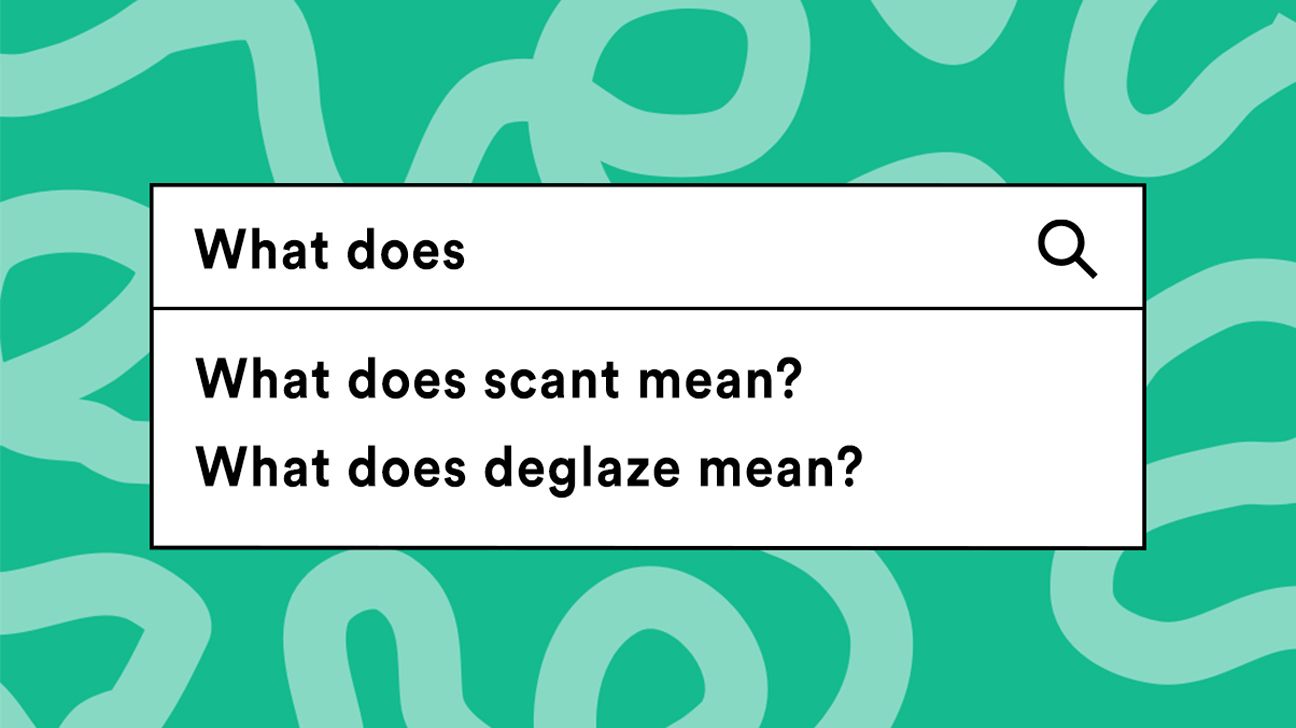No matter how experienced you are in the kitchen, sometimes the hardest part of following a recipe isn’t the process itself — it’s understanding what the recipe wants you to do in the first place.
Who can forget this iconic moment from “Schitt’s Creek”?

There’s a reason that scene resonated so hard. We’ve literally all been there before, whether folding in the cheese or trying to measure a “scant” teaspoon.
Have no fear. I’m here to demystify, explain, break down, and simplify some of the most common — and confusing — bits of recipe terminology, so you can start cooking without sweating what “sweating” means.
Folding can mean different things depending on whether you’re cooking or baking, but broadly it’s a gentle method of incorporating ingredients so as not to crush, deflate, or overmix them.
To fold: Draw a line down the center of your mixing bowl with the edge of your spatula, and then gently scoop, lift, and fold the mixture over itself by turning your wrist away from the center of the bowl. Rotate the bowl about 90 degrees after each fold. This is a slow and steady process. Just keep going until everything is combined.
If you’re making a delicate soufflé, folding prevents the beaten egg whites from collapsing. If you’re making mac and cheese, folding means you’re less likely to crush or tear the soft noodles. If you’re making muffins, cakes, or cookies, folding in additions like chocolate chips or blueberries means you’re less likely to overmix your batter.
“Scant” means “barely sufficient or adequate.” So, if a recipe calls for “a scant teaspoon,” it’s just telling you that slightly less than a teaspoon (but more than 3/4 teaspoon) is all you need.
This one confuses people because isn’t oil always shimmering? It’s hard. I know.
Next time you heat oil in a skillet, watch how it changes as it warms up. When you first pour the oil in, it tends to move around in drips and lines. As it warms up, it will loosen and spread out. When it’s shimmering, you might even notice waves or ripples along the surface — think almost like an oil slick. It’s subtle, though, so you’ll have to pay attention closely!
If you still can’t see the shimmer, just know: The goal is for your oil to be hot enough that your food doesn’t stick to the skillet but not so hot that it’s smoking. A droplet of water should immediately sizzle and evaporate when it hits the surface of the skillet, but if the oil starts smoking, drop the heat!
Pro tip
Wait for your skillet to get hot before you drizzle in the oil. The oil will heat up much more quickly, and you’ll be able to see the change in consistency happen right before your eyes.
Before I define “deglaze,” I’m going to teach you another word: “fond.” Fond is the brown bits of stuff that sticks to the bottom of your skillet when you’re searing or sautéing. Beginner cooks often panic at the sight of fond, thinking they’ve damaged the pan and it will be a nightmare to clean. But fond is actually totally normal.
Deglazing just means adding a splash of water, wine, or stock to your still-hot skillet and using a wooden spoon or spatula to loosen and scrape up the fond.
Many recipes that call for deglazing have you use the fond to make a pan sauce (sometimes thickening with flour or adding shallots and garlic). You can also deglaze just to scrape the surface of the pan clean once you’re done cooking and before you wash it.
A pot of gently simmering water is around 185–205°F, basically just below the boiling point of water (212°F).
For those of you who don’t keep a thermometer on hand, that means you’re looking for lots and lots of small trails of bubbles moving from the surface of the pot to the surface of the water without disrupting the surface of the water too much.
Pro tip
The best way to know for sure that you’ve achieved a gentle simmer is to first bring your pot to a boil and then reduce it to a simmer.
Emulsifying means combining two ingredients that don’t naturally want to combine (like oil and water). Some emulsions are unstable, such as salad dressings that separate if they sit undisturbed. Other emulsions are stable, such as mayonnaise, which is made from egg yolks and oil and can’t be separated once combined.
Some recipes might include emulsifying as a step in a larger process. For example, the reason you add eggs to cake batter one at a time at room temperature is to give each one time to fully emulsify with the creamed sugar and butter before you add the next one.
An easy way to remember what sweating means in cooking is to think about what sweating means in humans: Moisture is released and things get, uh, aromatic. Unlike sautéing, sweating involves cooking foods (usually onions and celery, but it can be done with other veggies too) on low heat so that they soften and release moisture without browning.
Sweating is a slow and steady process, so don’t rush it.
Check it
The best way to tell when your food is properly sweated is to taste it. If it still tastes raw or crunchy, keep sweating.
An egg wash is a beaten egg that you brush onto a baked good before baking to give it a shiny crust and/or to help the toppings stick to it. Egg washes can also be used like glue to help puff pastry and pie dough stick together.
The most basic, common egg wash is made from a well beaten whole egg. Some recipes might include a splash of water and pinch of salt to thin out the egg and make it easier to whisk.
There are lots of different variations on egg washes, including ones made with just yolks or just whites and others that are mixed with milk or heavy cream. Some will help give a baked good a softer or harder crust, but most of the time, egg washes are used primarily for aesthetic purposes.
Shallots are confusing. Some are just slightly larger than large garlic cloves, and others are the size of small onions. Some come with two connected bulbs, while others fly solo.
Generally speaking, “a shallot” means a single shallot bulb. If a recipe doesn’t specify what size of shallot, don’t stress — think of it as permission from the recipe gods to adjust the recipe to your personal preference. You can use two or three smaller shallots, one medium shallot, or a whole large shallot — it really depends on what you prefer.
If a recipe calls for “2 cups walnuts, chopped,” that means you measure 2 cups of whole walnuts and then chop them.
If a recipe says “2 cups chopped walnuts,” that means you measure 2 cups of already-chopped walnuts.
What’s the difference? Whole walnuts are bigger and have lots of space between them, meaning there’s a lot more air in the measuring cup. Chopping 2 cups of whole walnuts will produce a smaller amount of chopped walnuts than you would have if you measured 2 cups of chopped walnuts.
These three words basically describe the same thing done to different sizes. Chopped is the biggest, diced is the middle size, and minced is very small.
A chop is usually rougher and often less uniform in size — maybe even 1-to-2-inch pieces. For a dice and a mince, you don’t have to break out a ruler or anything, but generally speaking, diced = 1/4-inch pieces and minced = 1/8-inch pieces.
You might see variations like “large dice” and “small dice,” but again, no need to break out a ruler. If you accidentally cut your ingredients smaller or bigger than the recipe says, just adjust the cooking time accordingly.

